Expanding the Efficacy of Fingermark Enhancement Using ToF-SIMS
Abstract
1. Introduction
2. Results and Discussion
2.1. Sequential Enhancement by ToF-SIMS Following Standard Processes
2.2. Limitations
3. Materials and Methods
3.1. Fingerprint Deposition
3.2. Cyanoacrylate Fuming and Basic Yellow 40 Dye Staining
3.3. Black Powder Suspension
3.4. ToF-SIMS Imaging
3.5. Scoring Fingerprints
4. Conclusions
Supplementary Materials
Author Contributions
Funding
Institutional Review Board Statement
Informed Consent Statement
Data Availability Statement
Acknowledgments
Conflicts of Interest
References
- Francese, S. Emerging Technologies for the Analysis of Forensic Traces; Springer: New York, NY, USA, 2019. [Google Scholar]
- Great Britain Home Office. Fingermark Visualisation Manual; TSO: London, UK, 2014. [Google Scholar]
- Bleay, S.M. Fingerprint Source Book; Home Office: London, UK, 2012. [Google Scholar]
- Holder, E.H.; Robinson, L.O.; Laub, J.H. The Fingerprint Sourcebook; US Department of Justice: Washington, DC, USA, 2012.
- Bleay, S.M. Interpreting the results of fingermark enhancement. In Fingerprint Development Techniques; John Wiley & Sons Ltd.: Hoboken, NJ, USA, 2018; pp. 469–488. [Google Scholar]
- Bumbrah, G.S. Cyanoacrylate fuming method for detection of latent fingermarks: A review. Egypt. J. Forensic Sci. 2017, 7, 4. [Google Scholar] [CrossRef] [PubMed]
- Sodhi, R.N.S. Time-of-flight secondary ion mass spectrometry (TOF-SIMS): Versatility in chemical and imaging surface analysis. Analyst 2004, 129, 483–487. [Google Scholar] [CrossRef] [PubMed]
- Croxton, R.S.; Bleay, S.M.; de Puit, M. Composition and properties of fingermarks. In Fingerprint Development Techniques; John Wiley & Sons Ltd.: Hoboken, NJ, USA, 2018; pp. 35–68. [Google Scholar]
- Buchberger, A.R.; Delaney, K.; Johnson, J.; Jillian, J. Mass spectrometry imaging: A review of emerging advancements and future insights. Anal. Chem. 2018, 90, 240–265. [Google Scholar] [CrossRef] [PubMed]
- Hinder, S.J.; Watts, J.F. SIMS fingerprint analysis on organic substrates. Surf. Interface Anal. 2010, 42, 826–829. [Google Scholar] [CrossRef]
- Bradshaw, R.; Bradshaw, R.; Wilson, G.; Denison, N.; Francese, S. Application of MALDI MS imaging after sequential processing of latent fingermarks. Forensic Sci. Int. 2021, 319, 110643. [Google Scholar] [CrossRef] [PubMed]
- Bailey, M.J.; Bright, N.J.; Croxton, R.S.; Francese, S.; Ferguson, L.S.; Hinder, S.; Jickells, S.; Jones, B.J.; Jones, B.N.; Kazarian, S.G.; et al. Chemical characterization of latent fingerprints by matrix-assisted laser desorption ionization, time-of-flight secondary ion mass spectrometry, mega electron volt secondary mass spectrometry, gas chromatography/mass spectrometry, X-ray photoelectron spectroscopy, and attenuated total reflection Fourier transform infrared spectroscopic imaging: An intercomparison. Anal. Chem. 2012, 84, 8514–8523. [Google Scholar] [PubMed]
- Szynkowska, M.I.; Czerski, K.; Grams, J.; Paryjczak, T.; Parczewski, A. Preliminary studies using imaging mass spectrometry TOF-SIMS in detection and analysis of fingerprints. Imaging Sci. J. 2007, 55, 180–187. [Google Scholar] [CrossRef]
- Bailey, M.J.; Ismail, M.; Bleay, S.; Bright, N.; Elad, M.L.; Cohen, Y.; Geller, B.; Everson, D.; Costa, C.; Webb, R.P.; et al. Enhanced imaging of developed fingerprints using mass spectrometry imaging. Analyst 2013, 138, 6246–6250. [Google Scholar] [CrossRef] [PubMed]
- Lee, C.J.; Scurr, D.J.; Jiang, L.; Kenton, A.; Beebe, S.R.T.; Sharp, J.S. Imaging mass spectrometry of fingermarks on brass bullet casings using sample rotation. Analyst 2021, 146, 7563–7572. [Google Scholar] [CrossRef] [PubMed]
- Charlton, D.; Costa, C.; Trindade, G.F.; Hinder, S.; Watts, J.F.; Bailey, M.J. Improving the technological readiness of time of flight-secondary ion mass spectrometry for enhancing fingermark recovery—Towards operational deployment. Sci. Justice 2023, 63, 9–18. [Google Scholar] [CrossRef] [PubMed]
- Li, W.-J.; Sun, L.-H.; You, W.; Wang, L.-X.; Zhao, Y.-B.; Li, Z.-P. Chemical imaging of fingerprint on RMB banknotes using time-of-flight secondary ion mass spectrometry. Chin. J. Anal. Chem. 2020, 48, 1511–1518. [Google Scholar] [CrossRef]
- Croxton, R.S.; Baron, M.G.; Butler, D.; Kent, T.; Sears, V.G. Variation in amino acid and lipid composition of latent fingerprints. Forensic Sci. Int. 2010, 199, 93–102. [Google Scholar] [CrossRef] [PubMed]
- Jasuja, O.P.; Toofany, M.; Singh, G.; Sodhi, G. Dynamics of latent fingerprints: The effect of physical factors on quality of ninhydrin developed prints—A preliminary study. Sci. Justice 2009, 49, 8–11. [Google Scholar] [CrossRef] [PubMed]
- Jones, N.; Mansour, D.; Stoilovic, M.; Lennard, C.; Roux, C. The influence of polymer type, print donor and age on the quality of fingerprints developed on plastic substrates using vacuum metal deposition. Forensic Sci. Int. 2001, 124, 167–177. [Google Scholar] [CrossRef] [PubMed]
- Archer, N.E.; Charles, Y.; Elliott, J.A.; Jickells, S. Changes in the lipid composition of latent fingerprint residue with time after deposition on a surface. Forensic Sci. Int. 2005, 154, 224–239. [Google Scholar] [CrossRef] [PubMed]
- Weyermann, C.; Roux, C.; Champod, C. Initial results on the composition of fingerprints and its evolution as a function of time by GC/MS analysis. J. Forensic Sci. 2011, 56, 102–108. [Google Scholar] [CrossRef] [PubMed]
- O’Neill, K.C.; Lee, Y.J. Study of the cyanoacrylate fuming mechanism by matrix-assisted laser desorption/ionization mass spectrometry. J. Mass Spectrom. 2019, 54, 222–226. [Google Scholar] [CrossRef] [PubMed]
- Sears, V.G.; Bleay, S.; Bandey, H.; Bowman, V. A methodology for finger mark research. Sci. Justice 2012, 52, 145–160. [Google Scholar] [CrossRef] [PubMed]
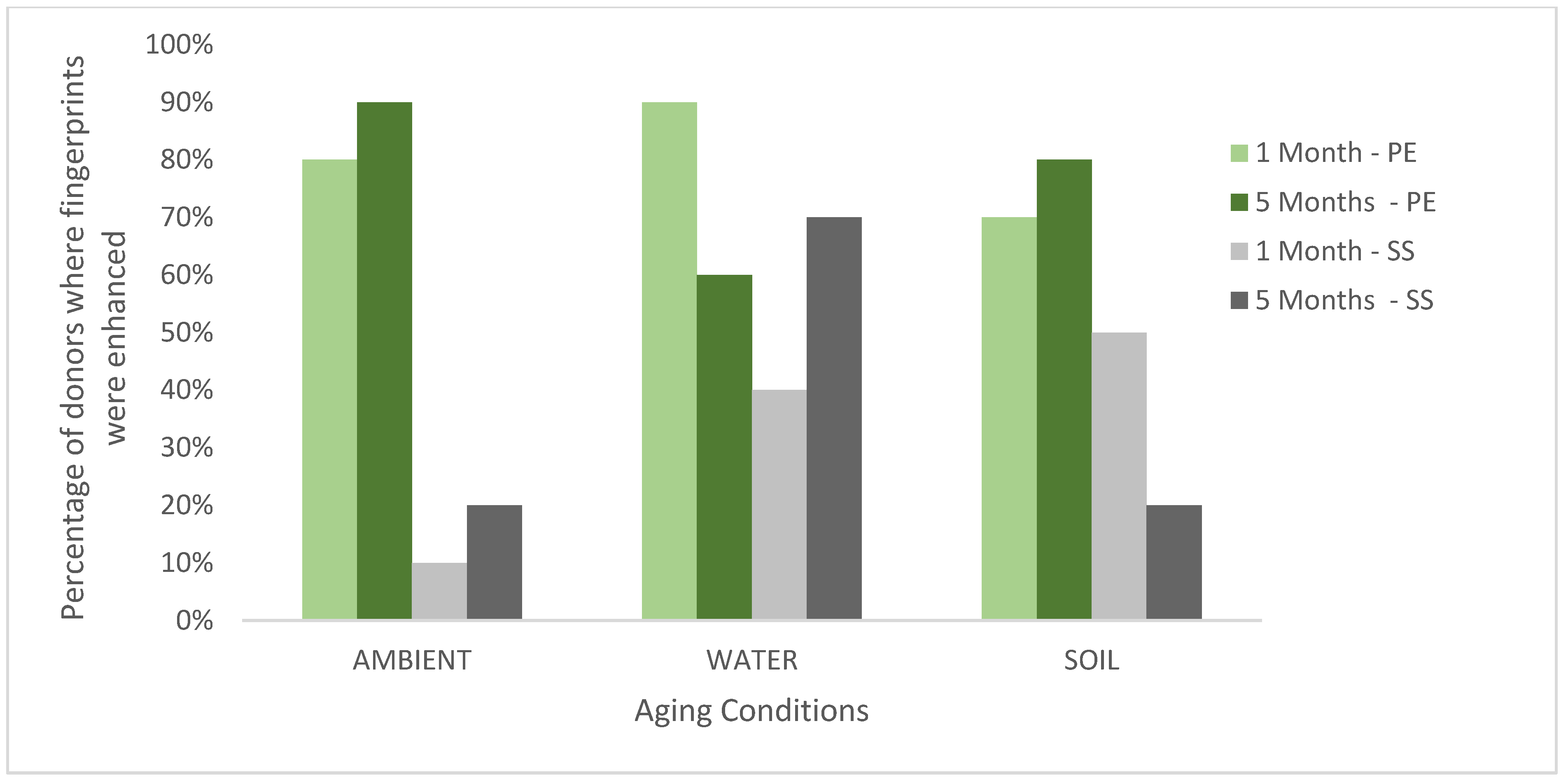
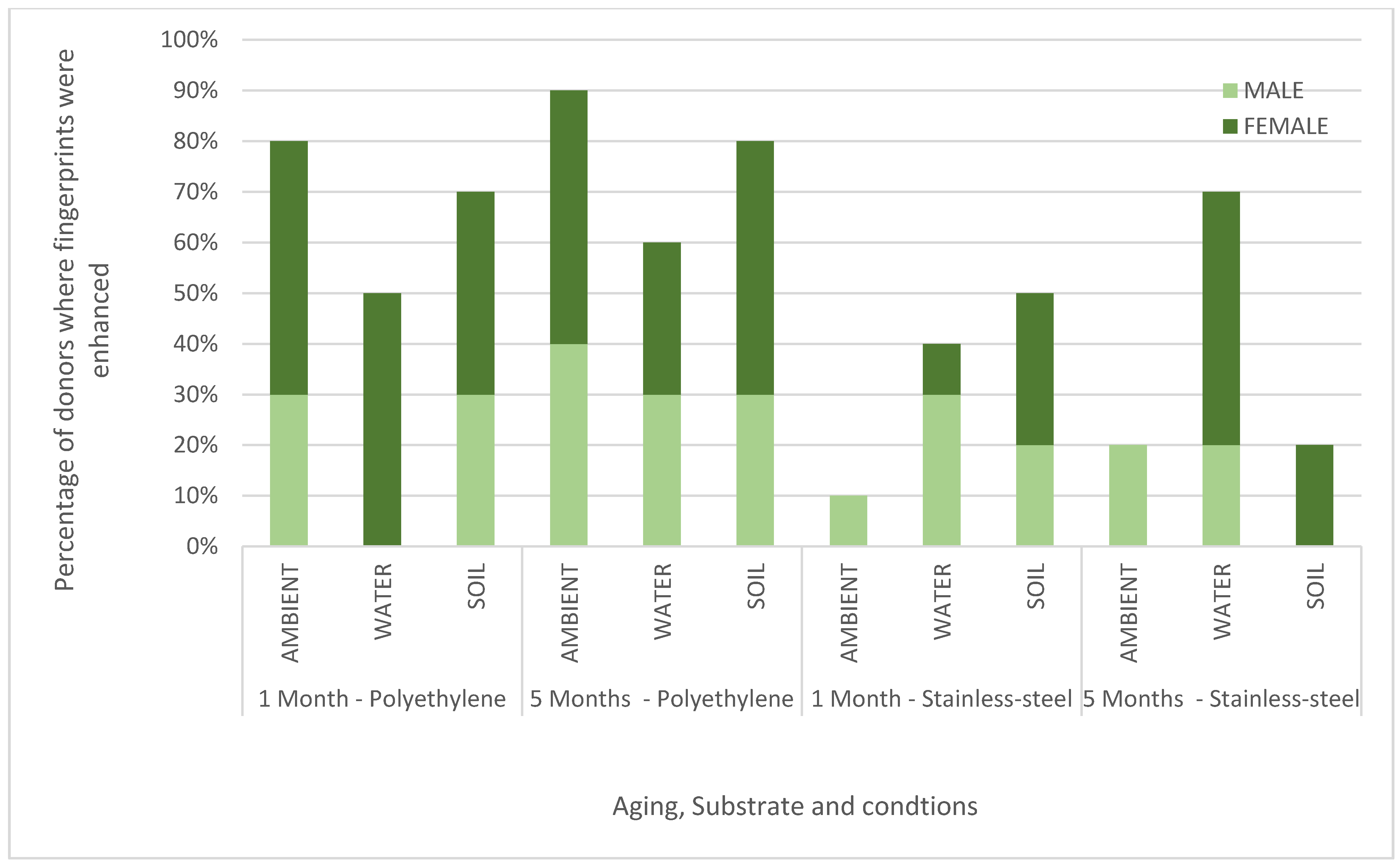


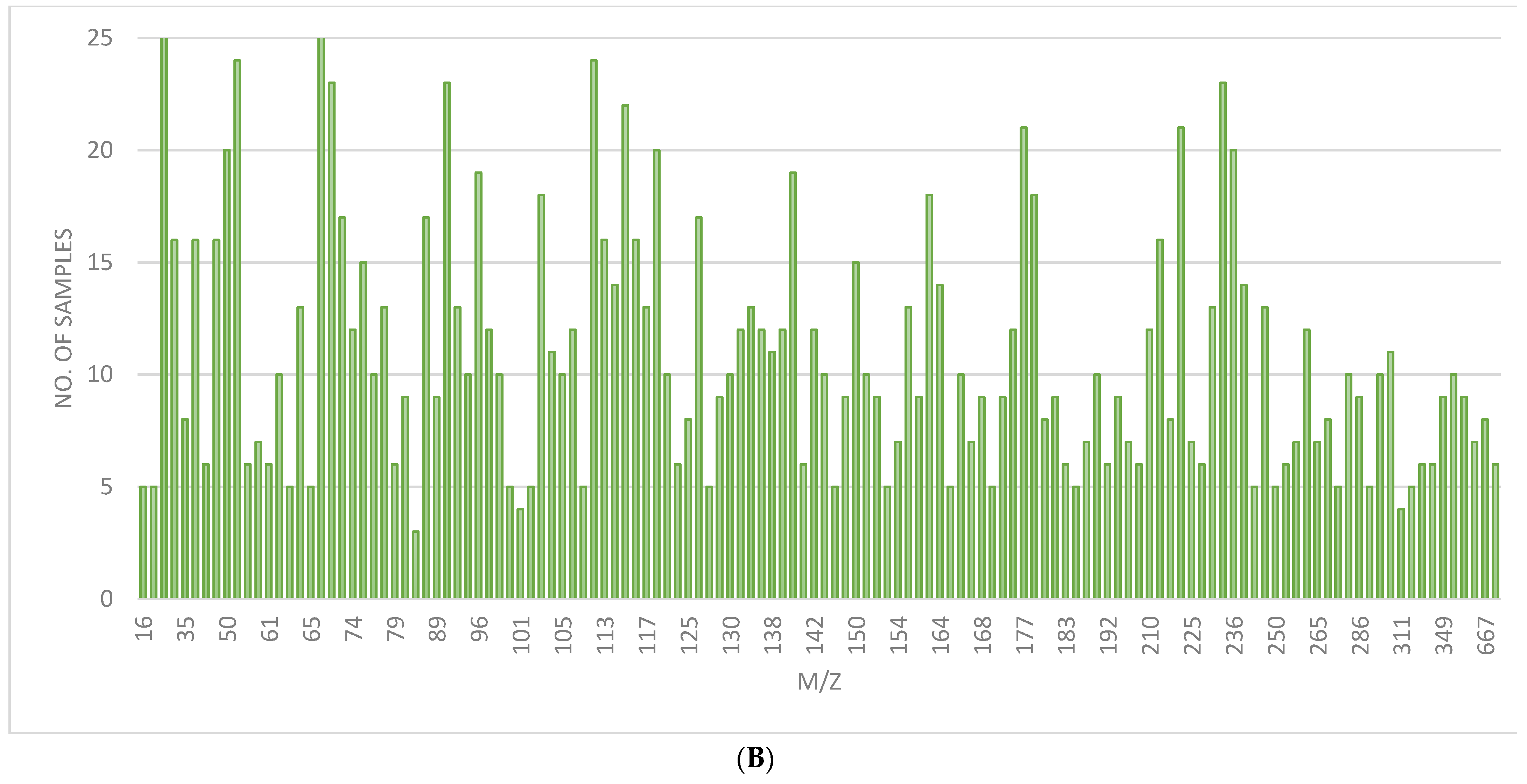

| CA and BY40 Image | ToF-SIMS Positive Image | ToF-SIMS Negative Image | |
|---|---|---|---|
| Substrate: PE Condition: Ambient Age: 5 Months Donor: M3 Deposition: 76 | 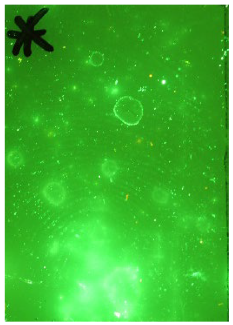 | 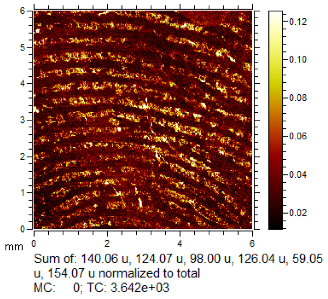 | 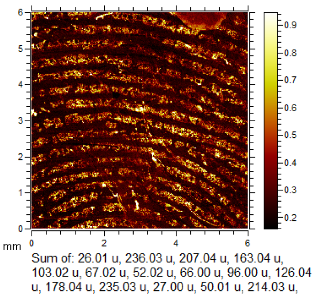 |
| Substrate: SS Condition: Ambient Age: 5 Months Donor: M3 Deposition: 21 |  | 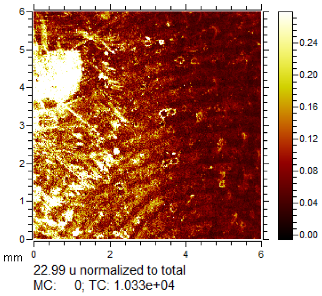 | 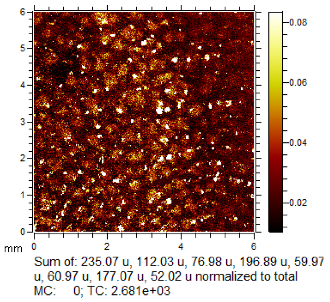 |
| Standard Process Image | ToF-SIMS Image | |
|---|---|---|
| Substrate: PE Condition: Soil Age: 1 Month Donor: M2 Deposition: 66 |  BPS | 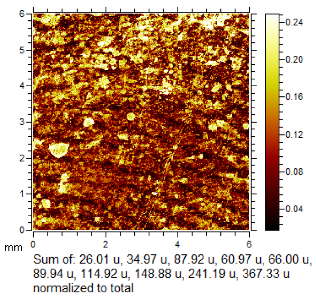 Negative Mode |
| Substrate: SS Condition: Water Age: 1 Month Donor: M4 Deposition: 1 |  BPS | 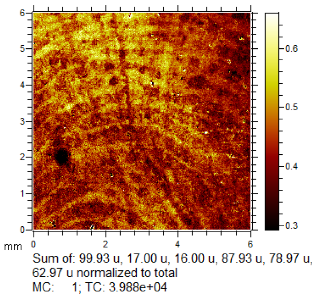 Negative Mode |
| Substrate: PE Condition: Soil Age: 5 Months Donor: F3 Deposition: 1 | 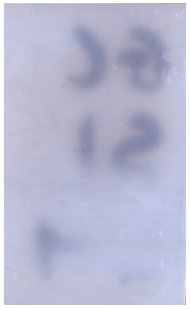 BPS | 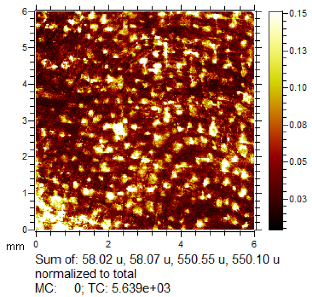 Positive Mode |
| Substrate: PE Condition: Ambient Age: 5 Months Donor: F5 Deposition: 26 | 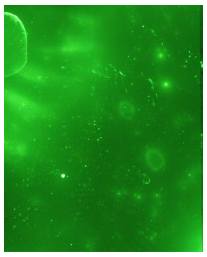 CA and BY40 | 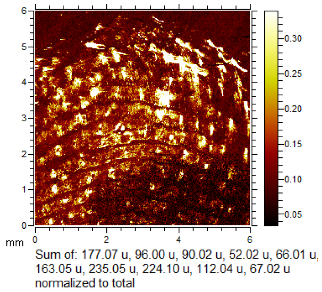 Negative Mode |
Disclaimer/Publisher’s Note: The statements, opinions and data contained in all publications are solely those of the individual author(s) and contributor(s) and not of MDPI and/or the editor(s). MDPI and/or the editor(s) disclaim responsibility for any injury to people or property resulting from any ideas, methods, instructions or products referred to in the content. |
© 2023 by the authors. Licensee MDPI, Basel, Switzerland. This article is an open access article distributed under the terms and conditions of the Creative Commons Attribution (CC BY) license (https://creativecommons.org/licenses/by/4.0/).
Share and Cite
Charlton, D.; Costa, C.; Hinder, S.J.; Watts, J.F.; Bailey, M.J. Expanding the Efficacy of Fingermark Enhancement Using ToF-SIMS. Molecules 2023, 28, 5687. https://doi.org/10.3390/molecules28155687
Charlton D, Costa C, Hinder SJ, Watts JF, Bailey MJ. Expanding the Efficacy of Fingermark Enhancement Using ToF-SIMS. Molecules. 2023; 28(15):5687. https://doi.org/10.3390/molecules28155687
Chicago/Turabian StyleCharlton, Deborah, Catia Costa, Steven J. Hinder, John F. Watts, and Melanie J. Bailey. 2023. "Expanding the Efficacy of Fingermark Enhancement Using ToF-SIMS" Molecules 28, no. 15: 5687. https://doi.org/10.3390/molecules28155687
APA StyleCharlton, D., Costa, C., Hinder, S. J., Watts, J. F., & Bailey, M. J. (2023). Expanding the Efficacy of Fingermark Enhancement Using ToF-SIMS. Molecules, 28(15), 5687. https://doi.org/10.3390/molecules28155687





